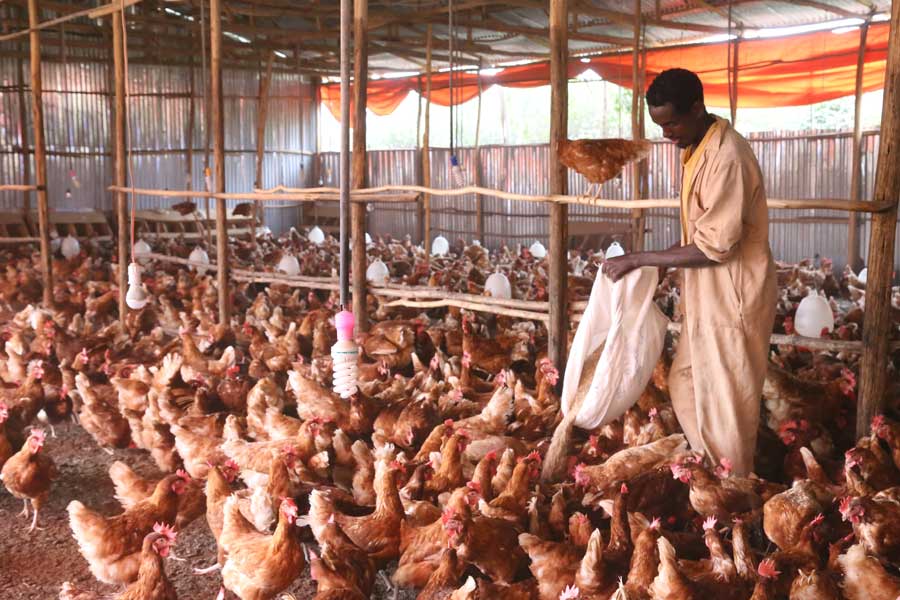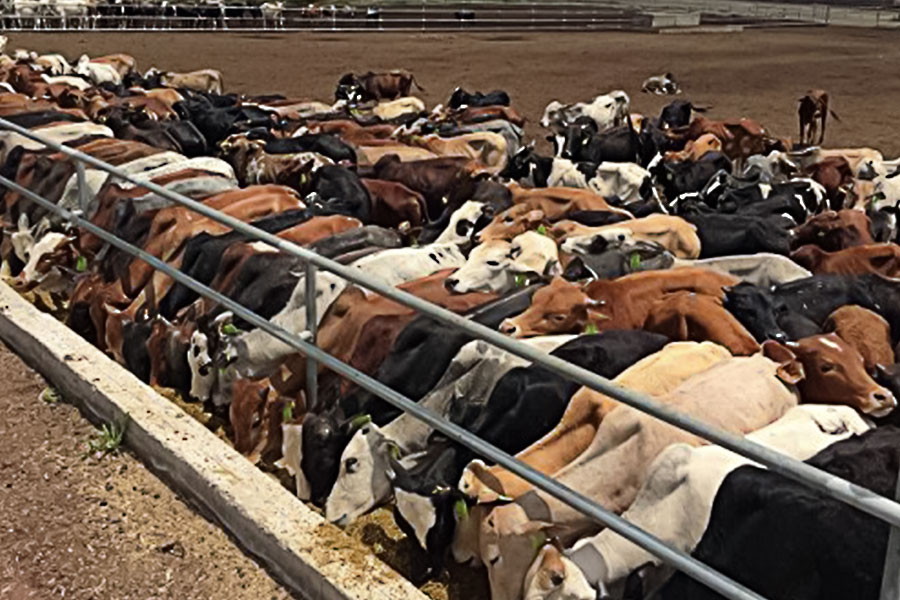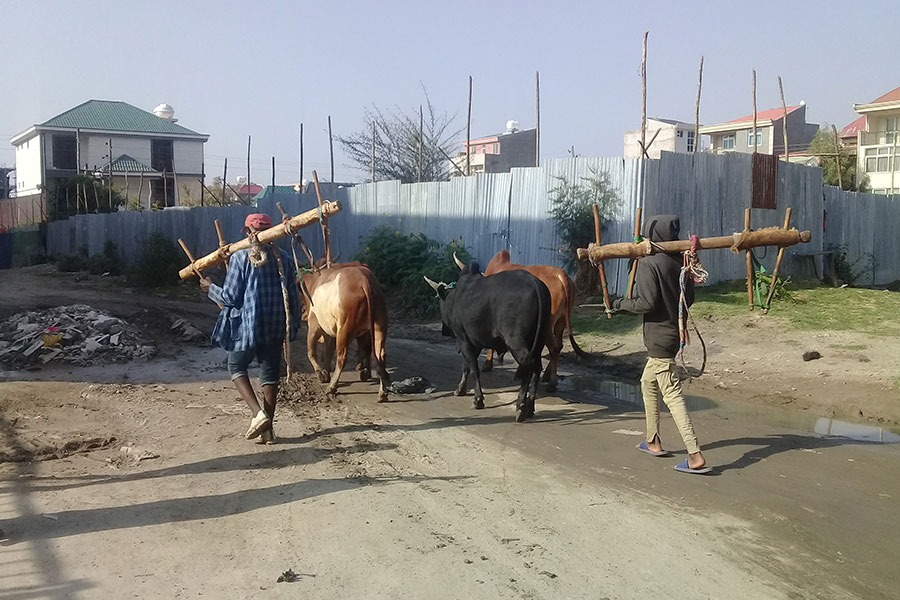
The recent price fluctuation of eggs had Henok Yehualawork, manager of a small pastry shop, in a dilemma of increasing the price of cakes or altering his recipe.
Either of the decisions impact the loyal customer base that favours consistency. Sitting on the rather idle highway Sierra Leone Street of the capital, Yehualawork Cafe thrives through long-standing customers who have come by to indulge in their "usual" preference for over a decade.
From cream pastry to soft cakes, a piece is sold from 45 Br to 80 Br, while the price of a whole cake reaches up to 650 Br a kilo. However, Henok, with his three brothers, finally decided to increase the price rather than compromise the flavour.
"It's the lesser of the two evils," he told Fortune.
The bakery acquires 150 eggs per week from wholesalers. Henok reports that the cost has unexpectedly increased by three Birr, as suppliers explain that a continuous rise in animal feed prices is causing them to suffer repeated losses.
Industry players ascribe the sudden upsurge in chicken feed inputs to production focused on human consumption. The feed, which constitutes of maize, barley, soybeans, bone meal, salt, and limestone, is often supplemented with imported processed mineral concentrates. The average inflation rate for imported additives stood at 41pc for the past five years due to the steadily increasing price trends of lysine, salt, and minerals, according to Feedepia, an animal feed resource information system.
Experts indicate the lack of processing facilities, with only two plants equipped for the final composition of chicken feeds, is a major constraint to quality and quantity.
One of the companies, EthioChicken, launched in 2010 with a breeder farm, feed mill, and hatchery on the outskirts of Bishoftu (Debre Zeit) town. Four years later, it installed plants in four regional states, processing 1.2 million quintals of chicken feed annually.
"It is hardly possible not to feel the pinch of inflation," said Mulugeta Abreha, feed business director at the company. He said the price of most inputs accessed from the domestic market is increasing at a breakneck speed while the shortage of foreign currency is an impediment to the imported ones.
According to Mulugeta, the production cost for imported inputs that used to constitute seven percent of the total has doubled this year, compelling them to produce at 40pc capacity apart from making price adjustments.
"Most farmers discontinued buying processed feed," he said.
Producers believe that the price raise after the idle fasting period gives them a lifeline to stay in business.
Established in 2016, the Ethiopian Poultry Producers & Processors Association has over 150 members from higher, medium, and lower farmholds. Birhanu Million, general manager of the Association, said although the lobbying campaign not to levy Value Added Tax on imported inputs to process chicken feed seem to have borne fruit, following intense negotiations with the Ministry of Agriculture, the production cost for eggs averages around 11 Br, making it difficult to abstain from price adjustment.
“It’s impossible,” he said.
Farmers lament that the retail price of eggs does not reflect the incessant inflation in the market, including labour costs and rent.
Zewdalem Getaneh is a poultry farmer who owns 640 laying hens. Like many others, he has been grappling with the rising costs of chicken feed. This year, he saw the retail price of a quintal, which feeds 500 newly hatched laying hens for a month shoot up from 3,200 Br to 4,000 Br.
"The production costs often surpass the market price," he told Fortune.
A properly rationed chicken feed can have a 70pc potential egg production increase, with a 98g formulated ration daily. The Ethiopian poultry population stands at 56.06 million birds, of which 88.1pc are indigenous breeds known for their small-size eggs with dark yellow yolk. Although less productive, they are preferred in the local market over hybrid and foreign breeds that account for 6.45pc and 5.36pc of the total.
A study conducted by FAOSTAT shows the annual consumption of eggs per person stands at 57 eggs while countries such as Japan are among the largest consumers with an average of 320 eggs per year. The global threshold stands at 180 eggs.
Experts emphasize the direct correlation between animal husbandry productivity and the availability of sufficient feed. The scarcity of raw materials in the Ethiopian poultry sector is heightened by the shortage of foreign currency.
Yohannes Tsegaye, a veterinary specialist and consultant on animal feed for the past seven years, highlights the absence of essential elements such as supplementary minerals, protein, and premix in locally produced animal feed leaves most processors at the mercy of a small group of importers.
However, the disparity between the demand and supply of animal feed is not the only issue. Yohannes observes that farmers engaging in the poultry sector opt to compromise the quantity of feed that ought to be given to the egg-laying hens resulting in poor production and quality of eggs.
"Companies main target is maximizing profit at any cost," he told Fortune.
The most prominent variants, Sasso breeds of hens, which are commonly used for broilers and laying, are known for their short egg-laying periods and high feed consumption, compared to more prolific breeds like the white leghorns that can produce over 300 eggs annually for more than three years on average.
Yohannes pointed out that hatcheries and large animal feed processing companies are failing to meet the growing demand from farmers. They often sell unsuitable breeds of egg-laying chickens and processed feeds to boost their animal feed sales. He recalled that the government had set a target to reduce the retail price of eggs by half a few years ago, but is falling short of the initial plan.
"It is not possible to achieve such targets without laying the groundwork," he told Fortune.
There are 32 privately owned and 28 cooperative animal feed processing facilities. Despite the demand for one million tons of compound feed, a little over its quarter was supplied due to a shortage of raw materials and technical capacity limitations. It was possible to supply 69.8pc of the demand for chicken feed with a 932,810qtl deficit, a couple of years ago. The price of maize and soya bean cereal grain inputs have more than tripled, leading to an 85.5pc hike in chicken feed prices.
The trajectory indicates the gap between demand and supply will widen as poultry feed processing plants receive 68.7pc of the required raw materials.
Besides animal feed constraints taking the spotlight for the price increase, studies conducted to assess the productivity and state of poultry in Ethiopia indicate the intensity of poultry farming and dominant indigenous breeds contribute to the underperformance.
Although there is an increasing demand for eggs, particularly in urban areas, the majority of poultry farming in Ethiopia is still dominated by domestic farms, which account for over 99pc of production. A study conducted by Abebe Gelete in 2022 on the state of poultry farming in Ethiopia highlighted several issues, including a lack of adequate feed, veterinary services, less productive breeds, and poor bio-security measures, which have hindered domestic farmers from producing beyond their household needs.
Officials at the Ministry of Agriculture chose to address the intermediaries in the market, which they believe contribute to the inaccessibility of eggs for consumers.
Tsigereda Fikadu, head of animal resource development at the Ministry, acknowledges that the flawed trade system is causing a disconnect between poultry farmers and their consumers.
She points out that the more intermediaries involved in the supply chain, the higher the value-added tax (VAT) imposed on the final consumer. Despite the challenges of illegal actors, Tsigereda believes that increasing production is a feasible solution.
"We need to scale up production," she told Fortune.
The Ministry of Agriculture recently introduced an ambitious 10-year plan called the 'Ten in Ten' initiative, which aims to strengthen 10 agricultural sectors, including the poultry industry, by tripling the current annual production of 3.2 billion eggs.
Officials say the focus is to improve the capabilities of small farms to produce beyond their own needs and to aid companies in importing parent stocks to spread the most productive varieties. Yet, conundrums such as ensuring a suitable business environment for the proper management and supply of poultry production and providing indispensable resources, remain unanswered.
PUBLISHED ON
Jun 10,2023 [ VOL
24 , NO
1206]

Radar | Oct 22,2022

Featured | Sep 04,2021

Fortune News | Jul 25,2020

Viewpoints | Jan 15,2022

Fortune News | Sep 24,2022

Radar | Jun 18,2022

Fortune News | Apr 22,2022

Agenda | Mar 19,2022

Fortune News | Jun 24,2023

Fortune News | Jun 12,2021

Jul 13 , 2024 . By AKSAH ITALO
Investors who rely on tractors, trucks, and field vehicles for commuting, transportin...

Jul 13 , 2024 . By MUNIR SHEMSU
The cracks in Ethiopia's higher education system were laid bare during a synthesis re...

Jul 13 , 2024 . By AKSAH ITALO
Construction authorities have unveiled a price adjustment implementation manual for s...

Jul 13 , 2024
The banking industry is experiencing a transformative period under the oversight of N...

Jul 20 , 2024
In a volatile economic environment, sudden policy reversals leave businesses reeling...

Jul 13 , 2024
Policymakers are walking a tightrope, struggling to generate growth and create millio...

Jul 7 , 2024
The federal budget has crossed a symbolic threshold, approaching the one trillion Bir...

Jun 29 , 2024
In a spirited bid for autonomy, the National Bank of Ethiopia (NBE), under its younge...